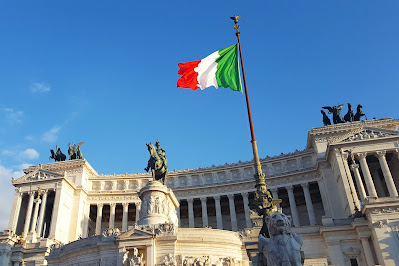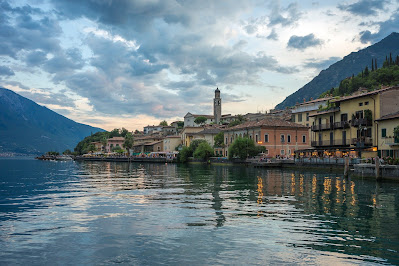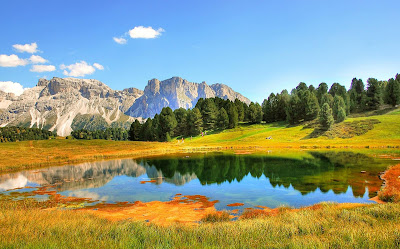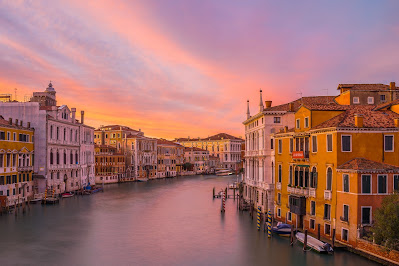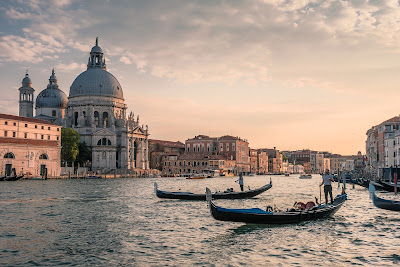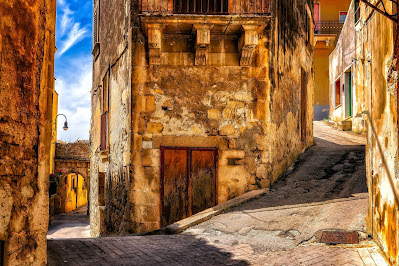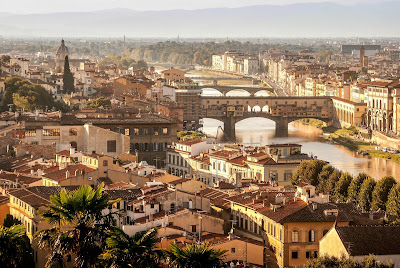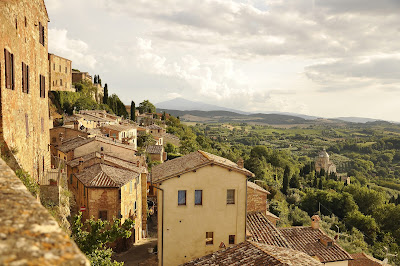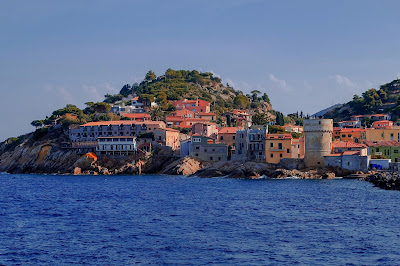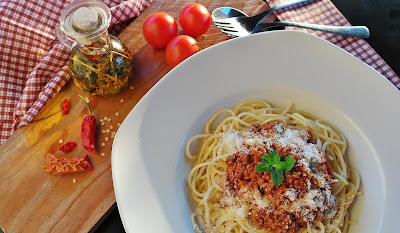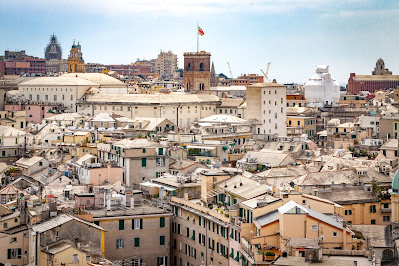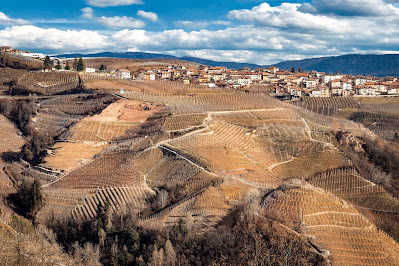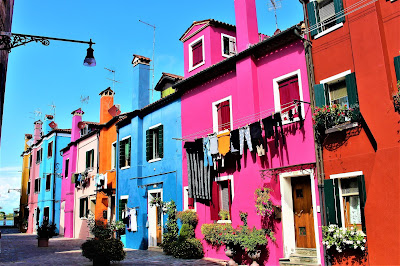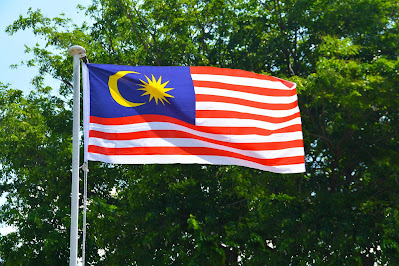All About Italy
Official Name: Italian Republic
Geography
Area: 301,225 sq. km. (116,303 sq. mi.); about the size of Georgia and Florida combined.
Cities: Capital--Rome (pop. 2.8 million, 3.7 million metro). Other cities--Milan (1.3 million, 3.9 metro), Naples (975,000, 3 million metro), Turin (900,000, 2.1 million metro).
Terrain: Mostly rugged and mountainous.
Climate: Generally mild Mediterranean; cold northern winters.
People
Nationality: Noun and adjective--Italian(s).
Population (November 2009 est.): 60.3 million.
Annual population growth rate (2008 est.): 0.07%, mostly due to immigration.
Ethnic groups: Primarily Italian, but there are small groups of German-, French-, Slovene-, and Albanian-Italians.
Religion: Roman Catholic (majority).
Language: Italian (official).
Education: Years compulsory--16. Literacy--98%.
Health: Infant mortality rate--3.7/1,000 live births. Life expectancy--78.8 years for men; 84.1 years for women.
Work force (24.97 million, 2009): Services--67%; industry and commerce--29%; agriculture--4%. Unemployment rate is 7.8%.
Government
Type: Republic since June 2, 1946.
Constitution: January 1, 1948.
Branches: Executive--president (chief of state), Council of Ministers (cabinet) headed by the president of the council (prime minister). Legislative--bicameral parliament: 630-member Chamber of Deputies, 315-member Senate (plus a varying number of "life" Senators). Judicial--independent constitutional court and lower magistracy.
Subdivisions: 94 provinces, 20 regions.
Political parties: People of Liberty, Democratic Party, Northern League, Italy of Values, Union of the Center, Movement for Autonomy.
Suffrage: Vote for House is universal over 18; vote for Senate is universal over 25.
Economy
GDP (purchasing power parity, 2009): $1.8 trillion.
GDP per capita (purchasing power parity, 2009): $29,500.
GDP growth: -5.0% (2009); -1.0% (2008); 1.5% (2007); 1.8% (2006); 0.5% (2005); 1.5% (2004), 0.0% (2003 est.); 0.5% (2002); 1.8% (2001).
Natural resources: Fish and natural gas.
Agriculture: Products--wheat, rice, grapes, olives, citrus fruits, potatoes, sugar beets, soybeans beef, dairy products.
Industry: Types--tourism, machinery, iron and steel, chemicals, food processing, textiles, motor vehicles, clothing, footwear, ceramics.
Trade: Exports (2009)--$402.9 billion f.o.b.: mechanical products, textiles and apparel, transportation equipment, metal products, chemical products, food and agricultural products. Partners (2008)--Germany 12.8%, France 11.8%, Spain 6.5%, U.S. 6.3%, U.K. 5.3%. Imports (2009)--$408.6 billion f.o.b.: machinery and transport equipment, foodstuffs, ferrous and nonferrous metals, wool, cotton, energy products. Partners (2008)--Germany 16.0%, France 8.6%, China 6.3%, Netherlands 5.4%, Russia 4.3%, Spain 3.9%, Belgium 3.8%.
PEOPLE AND HISTORY
Italy is largely homogeneous linguistically and religiously but is diverse culturally, economically, and politically. Italy has the fifth-highest population density in Europe--about 200 persons per square kilometer (about 500 per sq. mi.). Minority groups are small, the largest being the German-speaking people of Bolzano Province and the Slovenes around Trieste. There are also small communities of Albanian, Greek, Ladino, and French origin. Immigration has increased in recent years, however, while the Italian population is declining overall due to low birth rates. Although Roman Catholicism is the majority religion--85% of native-born citizens are nominally Catholic--all religious faiths are provided equal freedom before the law by the constitution.
Greeks settled in the southern tip of the Italian Peninsula in the eighth and seventh centuries B.C.; Etruscans, Romans, and others inhabited the central and northern mainland. The peninsula subsequently was unified under the Roman Republic. The neighboring islands came under Roman control by the third century B.C.; by the first century A.D., the Roman Empire effectively dominated the Mediterranean world. After the collapse of the Roman Empire in the West in the fifth century A.D., the peninsula and islands were subjected to a series of invasions, and political unity was lost. Italy became an oft-changing succession of small states, principalities, and kingdoms, which fought among themselves and were subject to ambitions of foreign powers. Popes of Rome ruled central Italy; rivalries between the popes and the Holy Roman Emperors, who claimed Italy as their domain, often made the peninsula a battleground.
The commercial prosperity of northern and central Italian cities, beginning in the 11th century, combined with the influence of the Renaissance, mitigated somewhat the effects of these medieval political rivalries. Although Italy declined after the 16th century, the Renaissance had strengthened the idea of a single Italian nationality. By the early 19th century, a nationalist movement developed and led to the reunification of Italy--except for Rome--in the 1860s. In 1861, Victor Emmanuel II of the House of Savoy was proclaimed King of Italy. Rome was incorporated in 1870. From 1870 until 1922, Italy was a constitutional monarchy with a parliament elected under limited suffrage.
20th-Century History
During World War I, Italy renounced its standing alliance with Germany and Austria-Hungary and, in 1915, entered the war on the side of the Allies. Under the postwar settlement, Italy received some former Austrian territory along the northeast frontier. In 1922, Benito Mussolini came to power and, over the next few years, eliminated political parties, curtailed personal liberties, and installed a fascist dictatorship termed the Corporate State. The king, with little or no effective power, remained titular head of state.
Italy allied with Germany and declared war on the United Kingdom and France in 1940. In 1941, Italy--with the other Axis powers, Germany and Japan--declared war on the United States and the Soviet Union. Following the Allied invasion of Sicily in 1943, the King dismissed Mussolini and appointed Marshal Pietro Badoglio as Premier. The Badoglio government declared war on Germany, which quickly occupied most of the country and freed Mussolini, who led a brief-lived regime in the north. An anti-fascist popular resistance movement grew during the last two years of the war, harassing German forces before they were driven out in April 1945. A 1946 plebiscite ended the monarchy, and a constituent assembly was elected to draw up plans for the republic.
Under the 1947 peace treaty, minor adjustments were made in Italy's frontier with France, the eastern border area was transferred to Yugoslavia, and the area around the city of Trieste was designated a free territory. In 1954, the free territory, which had remained under the administration of U.S.-U.K. forces (Zone A, including the city of Trieste) and Yugoslav forces (Zone B), was divided between Italy and Yugoslavia, principally along the zonal boundary. This arrangement was made permanent by the Italian-Yugoslav Treaty of Osimo, ratified in 1977 (currently being discussed by Italy, Slovenia, and Croatia). Under the 1947 peace treaty, Italy relinquished its overseas territories and certain Mediterranean islands.
The Roman Catholic Church's status in Italy has been determined, since its temporal powers ended in 1870, by a series of accords with the Italian Government. Under the Lateran Pacts of 1929, which were confirmed by the present constitution, Vatican City is recognized by Italy as an independent, sovereign entity. While preserving that recognition, in 1984, Italy and the Vatican updated several provisions of the 1929 accords. Included was the end of Roman Catholicism as Italy's formal state religion.
Italy's Cultural Contributions
Europe's Renaissance period began in Italy during the 14th and 15th centuries. Literary achievements--such as the poetry of Petrarch, Tasso, and Ariosto and the prose of Boccaccio, Machiavelli, and Castiglione--exerted a tremendous and lasting influence on the subsequent development of Western civilization, as did the painting, sculpture, and architecture contributed by giants such as da Vinci, Raphael, Botticelli, Fra Angelico, and Michelangelo.
The musical influence of Italian composers Monteverdi, Palestrina, and Vivaldi proved epochal; in the 19th century, Italian romantic opera flourished under composers Gioacchino Rossini, Giuseppe Verdi, and Giacomo Puccini. Contemporary Italian artists, writers, filmmakers, architects, composers, and designers contribute significantly to Western culture.
GOVERNMENT
Italy has been a democratic republic since June 2, 1946, when the monarchy was abolished by popular referendum. The constitution was promulgated on January 1, 1948.
The Italian state is centralized. The prefect of each of the provinces is appointed by and answerable to the central government. In addition to the provinces, the constitution provides for 20 regions with limited governing powers. Five regions--Sardinia, Sicily, Trentino-Alto Adige, Valle d'Aosta, and Friuli-Venezia Giulia--function with special autonomy statutes. The other 15 regions were established in 1970 and vote for regional "councils." The establishment of regional governments throughout Italy has brought some decentralization to the national governmental machinery, and recent governments have devolved further powers to the regions. Many regional governments, particularly in the north of Italy, are seeking additional powers.
The 1948 constitution established a bicameral parliament (Chamber of Deputies and Senate), a separate judiciary, and an executive branch composed of a Council of Ministers (cabinet), headed by the president of the council (prime minister). The president of the republic is elected for seven years by the parliament sitting jointly with a small number of regional delegates. The president nominates the prime minister, who chooses the other ministers. The Council of Ministers--in practice composed mostly of members of parliament--must retain the confidence of both houses.
The houses of parliament are popularly and directly elected by a proportional representation system. Under 2005 legislation, the Chamber of Deputies has 630 members (12 of whom are elected by Italians abroad). In addition to 315 elected members (six of whom are elected by Italians abroad), the Senate includes former presidents and several other persons appointed for life according to special constitutional provisions. Both houses are elected for a maximum of five years, but either may be dissolved before the expiration of its normal term. Legislative bills may originate in either house and must be passed by a majority in both.
The Italian judicial system is based on Roman law modified by the Napoleonic code and subsequent statutes. There is only partial judicial review of legislation in the American sense. A constitutional court, which passes on the constitutionality of laws, is a post-World War II innovation. Its powers and the volume and frequency of its decisions are not as extensive as those of the U.S. Supreme Court.
POLITICAL CONDITIONS
Until recently, there had been frequent government turnovers (more than 60 and counting) since 1945. The dominance of the Christian Democratic (DC) party during much of the postwar period lent continuity and comparative stability to Italy's political situation.
From 1992 to 1997, Italy faced significant challenges as voters--disenchanted with past political paralysis, massive government debt, extensive corruption, and organized crime's considerable influence--demanded political, economic, and ethical reforms. In 1993 referendums, voters approved substantial changes, including moving from a proportional to a largely majoritarian electoral system and the abolishment of some ministries. However in 2005, parliament passed a new electoral law based on full proportional assignment of seats.
Major political parties, beset by scandal and loss of voter confidence, underwent far-reaching changes. New political forces and new alignments of power emerged in March 1994 national elections. The election saw a major turnover in the new parliament, with 452 out of 630 deputies and 213 out of 315 senators elected for the first time. The 1994 elections also swept media magnate Silvio Berlusconi--and his Freedom Pole coalition--into office as Prime Minister. Berlusconi, however, was forced to step down in January 1995 when one member of his coalition withdrew support. The Berlusconi government was succeeded by a technical government headed by Prime Minister Lamberto Dini, which fell in early 1996. New elections in 1996 brought a center-left coalition to government for the first time after World War II.
A series of center-left coalitions dominated Italy's political landscape between 1996 and 2001. In April 1996, national elections led to the victory of a center-left coalition (the Olive Tree) under the leadership of Romano Prodi. Prodi's government became the second-longest to stay in power before he narrowly lost a vote of confidence (by three votes) in October 1998. A new government was formed by Democratic Party of the Left leader and former-communist Massimo D'Alema. In April 2000, following a poor showing by his coalition in regional elections, D'Alema resigned. The succeeding center-left government, including most of the same parties, was headed by Giuliano Amato, who had previously served as Prime Minister in 1992-93.
National elections, held on May 13, 2001, returned Berlusconi to power at the head of the five-party center-right Freedom House coalition, comprising the prime minister's own party, Forza Italia, the National Alliance, the Northern League, the Christian Democratic Center, and the United Christian Democrats. This Berlusconi government served its entire term.
In national elections held April 9-10, 2006, Romano Prodi's center-left Union coalition won a narrow victory over Berlusconi's Freedom House coalition. The Union coalition included the Democratic Party (born of the November 2007 fusion of the Democrats of the Left and the Daisy Party), UDEUR (Union of Democrats for Europe), Rose in the Fist (made up by Italian Social Democrats and Italian Radical Party), Communist Renewal, the Italian Communist Party, Italy of Values, and the Greens.
In May 2006, the parliament elected Giorgio Napolitano as the Republic's President. President Napolitano formerly served as a lifetime senator, Minister of the Interior, and a member of the European Parliament as a member of center-left parties. President Napolitano's term ends in May 2013. The Senate, lower house, and regional representatives will vote to elect his successor.
In January 2008, the Prodi government fell when small coalition partner UDEUR withdrew support. In February, the President dissolved parliament and Silvio Berlusconi returned to power after defeating former Rome Mayor Walter Veltroni by a comfortable margin in elections on April 13-14, 2008. Berlusconi's winning coalition was composed of the People of Liberty (a union of Forza Italia and National Alliance), the Northern League, and the Movement for Autonomy. Berlusconi was sworn in as Prime Minister on May 8. Veltroni resigned as leader of the opposition in February 2009. His deputy, Dario Franceschini, was elected new Democratic Party (PD) leader until party primary elections held in October 2009, when Pierluigi Bersani was elected PD national secretary.
Italy's dramatic self-renewal transformed the political landscape between 1992 and 1997. Scandal investigations touched thousands of politicians, administrators, and businessmen; the shift from a proportional to majoritarian voting system also altered the political landscape.
Party changes were sweeping. The Christian Democratic Party dissolved; the Italian People's Party and the Christian Democratic Center emerged. Other major parties, such as the Socialists, saw support plummet. A new populist and free-market oriented movement, Forza Italia, gained wide support among moderate voters. The National Alliance broke from the neofascist Italian Social Movement. A trend toward two large coalitions--one on the center-left and the other on the center-right--emerged from the April 1995 regional elections. For the 1996 national elections, the center-left parties created the Olive Tree coalition while the center right united again under the Freedom Pole. The May 2001 elections ushered into power a refashioned center-right coalition dominated by Berlusconi's party, Forza Italia. The April 2006 elections returned the center-left to power under the eight-party Union coalition, a successor to the Olive Tree.
In October 2007, the Democrats of the Left and the Daisy parties officially merged to form the Democratic Party. Veltroni was chosen as party leader and was the center-left's candidate in the April 2008 elections. Silvio Berlusconi launched an alliance between his Forza Italia party and Gianfranco Fini's National Alliance. The parties ran together under the People of Liberty symbol in April 2008. The election greatly simplified parliament, dramatically reducing the numbers of parties, and for the first time since World War II, leaving communist parties out of parliament. People of Liberty (37.4%) won the largest share of the vote and took power in coalition with a strengthened Northern League (8.3%) and the tiny Movement for Autonomy (1.1%). The Democratic Party scored 33.2% and ran in alliance with Italy of Values (4.4%), while the Union of the Center (5.6%) ran alone.
In March 2009, Forza Italia and National Alliance changed the People of Liberty identification from an alliance to a party. The new mass center-right party is Italy's largest party and one of the largest in Europe. Party leaders define the party as post-ideological, charismatic, and pragmatic. It is led by Berlusconi.
ECONOMY
The Italian economy has changed dramatically since the end of World War II. From an agriculturally based economy, it has developed into an industrial state ranked as the world's sixth-largest market economy. Italy belongs to the Group of Eight (G-8) industrialized nations; it is a member of the European Union and the Organization for Economic Cooperation and Development (OECD).
Italy has few natural resources. With much land unsuited for farming, Italy is a net food importer. There are no substantial deposits of iron, coal, or oil. Proven natural gas reserves, mainly in the Po Valley and offshore in the Adriatic, constitute the country's most important mineral resource. Most raw materials needed for manufacturing and more than 80% of the country's energy sources are imported. Italy's economic strength is in the processing and the manufacturing of goods, primarily in small and medium-sized family-owned firms. Its major industries are precision machinery, motor vehicles, chemicals, pharmaceuticals, electric goods, and fashion and clothing.
Italy continues to grapple with budget deficits and high public debt--2.6% and 105.9% of GDP for 2008, respectively. Italy joined the European Monetary Union in 1998 by signing the Stability and Growth Pact, and as a condition of this Euro zone membership, Italy must keep its budget deficit beneath a 3% ceiling. The Italian Government has found it difficult to bring the budget deficit down to a level that would allow a rapid decrease of that debt. The worsening of the economic situation is expected to jeopardize this effort. The deficit is expected to grow well above the 3% ceiling in 2009 and 2010.
Italy's economic growth averaged only 0.8% in the period 2001-2008; 2008 GDP decreased 1.0%, largely due to the global economic crisis and its impact on exports and domestic demand. GDP contracted further as the Euro zone and world economies slowed; 2009 GDP decreased 5.0%.
Italy's closest trade ties are with the other countries of the European Union, with whom it conducts about 60.1% of its total trade (2007 data). Italy's largest European Union trade partners, in order of market share, are Germany (12.9%), France (11.4%), and the United Kingdom (5.8%). Italy continues to grapple with the effects of globalization, where certain countries (notably China) have eroded the Italian lower-end industrial product sector.
The Italian economy is also affected by a large underground economy--worth some 27% of Italy's GDP. This production is not subject, of course, to taxation and thus remains a source of lost revenue to the local and central government.
U.S.-Italy Economic Relations
The United States and Italy cooperate closely on major economic issues, including within the G-8. With a large population and a high per capita income, Italy was the United States' twelfth-largest trading partner in 2008, with total bilateral trade of $51.6 billion comprised of exports to Italy totaling $15.5 billion and imports from Italy worth $36.1 billion. The U.S.'s $20.7 billion deficit with Italy in 2008 was slightly below the $20.9 billion deficit registered in 2007. Machinery and aircraft are becoming important U.S. exports to Italy. U.S. foreign direct investment in Italy at the end of 2007 exceeded $28.4 billion.
Labor
Unemployment is a regional issue in Italy--low in the north, high in the south. The overall national rate is at its lowest level since 1992. Chronic problems of inadequate infrastructure, corruption, and organized crime act as disincentives to investment and job creation in the south. A significant underground economy absorbs substantial numbers of people, but they work for low wages and without standard social benefits and protections. Women and youth have significantly higher rates of unemployment than do men.
Unions claim to represent 40% of the work force. Most Italian unions are grouped in four major confederations: the General Italian Confederation of Labor (CGIL), the Italian Confederation of Workers' Unions (CISL), the Italian Union of Labor (UIL), and the General Union of Labor (UGL), which together claim 35% of the work force. These confederations formerly were associated with important political parties or currents, but they have evolved into fully autonomous, professional bodies. The CGIL, CISL, and UIL are affiliated with the International Confederation of Free Trade Unions (ICFTU) and customarily coordinate their positions before confronting management or lobbying the government. The confederations have had an important consultative role on national social and economic issues.
Agriculture
Italy's agriculture is typical of the division between the agricultures of the northern and southern countries of the European Union. The northern part of Italy produces primarily grains, sugar beets, soybeans, meat, and dairy products, while the south specializes in fruits, vegetables, olive oil, wine, and durum wheat. Even though much of its mountainous terrain is unsuitable for farming, Italy has a large work force (1.4 million) employed in farming. Most farms are small, with the average size being only seven hectares.
FOREIGN RELATIONS
Italy was a founding member of the European Community--now the European Union (EU). Italy was admitted to the United Nations in 1955 and is a member and strong supporter of the North Atlantic Treaty Organization (NATO), the Organization for Economic Cooperation and Development (OECD), the General Agreement on Tariffs and Trade/World Trade Organization (GATT/WTO), the Organization for Security and Cooperation in Europe (OSCE), and the Council of Europe. It chaired the CSCE (the forerunner of the OSCE) in 1994, the EU from July to December 1990, January to June 1996, and July to December 2003, and the G-8 in 2001 and in 2009. Italy served a two-year term on the UN Security Council in 2007-2008.
Italy firmly supports the United Nations and its international security activities. Italy led the UN mission in Lebanon (UNIFIL) and has actively participated in and deployed troops in support of UN peacekeeping missions in Somalia, Mozambique, and Timor-Leste. It has provided critical support for NATO and EU operations in Afghanistan, Bosnia, Kosovo, Albania, Georgia, and Chad. Italy, under NATO's ISAF, maintains a Provincial Reconstruction Team in the western Afghanistan province of Herat, commands RC-West, and maintains a Carabinieri police training center. Italy supports reconstruction and development assistance to the Iraqi people through humanitarian workers and other officials, particularly in Dhi Qar Province, and is a leading contributor to the NATO Training Mission-Iraq, with approximately 100 military personnel and Carabinieri police trainers. Currently almost 9,000 Italian troops are deployed, including 2,100 in Kosovo, 2,350 in Lebanon as part of UNIFIL, and over 2,600 in Afghanistan.
The Italian Government seeks to obtain consensus with other European countries on various defense and security issues within the EU as well as NATO. European integration and the development of common defense and security policies will continue to be of primary interest to Italy.
U.S.-ITALY RELATIONS
The United States enjoys warm and friendly relations with Italy. Italy is a leading partner in counterterrorism efforts. The two are NATO allies and cooperate in the United Nations, in various regional organizations, and bilaterally for peace, prosperity, and security. Italy has worked closely with the United States and others on such issues as NATO and UN operations as well as on assistance to Russia and the New Independent States; Lebanon; the Middle East peace process; multilateral talks; Somalia and Mozambique peacekeeping; and combating drug trafficking, trafficking in women and children, and terrorism.
Under longstanding bilateral agreements flowing from NATO membership, Italy hosts important U.S. military forces at Vicenza and Livorno (army); Aviano (air force); and Sigonella, Gaeta, and Naples--home port for the U.S. Navy Sixth Fleet. The United States has about 13,000 military personnel stationed in Italy. Italy hosts the NATO Defense College in Rome.
Italy remains a strong and active transatlantic partner which, along with the United States, has sought to foster democratic ideals and international cooperation in areas of strife and civil conflict. Toward this end, the Italian Government has cooperated with the United States in the formulation of defense, security, and peacekeeping policies.
Italy is a beautiful country but is one of those countries which you probably have some questions and preconceptions, before your coming to this special country. A place of olive oil, pasta, wine, mafia and sunshine, roman ruins and renaissance palaces, Italyhas a lot to give its tourists. Although some of these conceptions are amazing and interesting, it would be a shame if that was the only thing you come away with. Italy is certainly much more complex and stimulating than these concepts. Italy is a country full of interesting things for the casual tourist and the educated tourist, it has deep Roman Catholic roots. The tourists can stay weeks in important tourist centers without reason to feel bored, but it is equally simple to get off the beaten track. In the north, next to the Alps and the landscapes of the Po river, many cultural gems and highly developed industrial cities fascinate. In this exciting country the people live the "la vita Italiana".
Lombardia is the capital of Milan, city of business organization and haute couture, the tourist can easily stay weeks without being bored. Bergamo is only an hour of distance and has an upper Old Town. On every corner you will observe something new. Venice and Verona are the most famous tourist attractions in the north-east of Italy, maybe you can think about romantic love affairs here. The people can discover easily the beautiful landscapes of Italy, Verona province may be the more fascinating. Many persons say that the north-west of Italy is a paradise for every culinary interested traveler. For the people who adore the wine, Piemonte is related with Barolo and Barbaresco, the most famous wines made out of the Nebbiolo grape. Turin is the capital of Piemonte, this city provides more than just a starting point to visit these wine regions. Lots of tourist attractions like museums, modern art, music and book fairs make of this city, one of the notable Italian cities concerning cultural life. At the same time it is a booming industrial and multimedia city. One of the most popular areas in Italy is Tuscany which is located in central Italy. Known for it's beautiful landscape and picturesque towns and villages including Florence, Lucca, Siena and Cortona. The Tuscan region is a popular vacation destination with many nice hotels and villas for rent. However, you can’t talk about Italy without mentioning the beautiful capital. The Eternal City is the perfect place for a relaxed, cultural city-break, and renting one of the many Rome apartments is the ideal way to experience it. That way, you’ll be able to discover the secrets of Rome at your own pace, with the comfort of your own private space when you return home after a long day sightseeing and filling up on all the culinary delights Rome has to offer!
Buongiorno! Nonna’s Little Italy book is a celebration of Italian heritage. This is an Italian Party your family and friends will never forget. Nonna’s Little Italy party book includes a complete menu and recipes, ideas for the invitations, decorating, games, music, gifts and more. What can be prepared in advance and will need to be done the day of the party. Included you will find a complete timeline for cooking, shopping and preparing for the party. All the tools you need to have a successful party.
Venice is like no other place on earth. . . No cars are allowed in the city and the fastest way to travel within the city is by boat on the canals. This is their 'taxi' system and the 'boat taxis' are called 'vaparettos' and it was quite fun to 'boat hop' from one place to another to get around the city. I did NOT miss the noise of traffic at ALL!
Italy shares its northern alpine boundary with France, Switzerland, Austria and Slovenia. The independent countries of San Marino and the Vatican City are enclaves within Italian territory. Campione d'Italia is an Italian enclave in Switzerland.
Italy was home to many well-known and influential European civilizations, including the Etruscans, Greeks and the Romans. For more than 3,000 years Italy experienced migrations and invasions from Germanic, Celtic, Frankish, Lombard, Byzantine Greek, Saracen, Norman, and Angevin peoples, and was divided into many independent states until 1861 when Italy became a nation-state.
Italy is called "il Belpaese" (Italian for beautiful country) by its inhabitants, due to the beauty and variety of its landscapes and for having the world's largest artistic patrimony; the country is home to the greatest number of UNESCO World Heritage Sites (41 as of July 13, 2006).
Today, Italy is a highly developed country with the 7th highest GDP in 2006, a member of the G8 and a founding member of what is now the European Union, having signed the Treaty of Rome in 1957. Inhabitants of Italy are referred to as Italians (Italian: Italiani or poetically Italici).
History
The word Italy derives from the Homeric (Aeolic) word ιταλός [2], which means "bull". Excavations throughout Italy have found proof of people in Italy dating back to the Palaeolithic period (the "Old Stone Age") some 200,000 years ago. The first Greek settlers, who arrived in Italy from Euboea island the 8th century BC, possibly named their new land "land of bulls".
Italy has influenced the cultural and social development of the whole Mediterranean area, deeply influencing European culture as well. As a result, it has also influenced other important cultures. Such cultures and civilisations have existed there since prehistoric times. After Magna Graecia, the Etruscan civilisation and especially the Roman Republic and Empire that dominated this part of the world for many centuries, Italy was central to European science and art during the Renaissance.
Center of the Roman civilisation for centuries, Italy lost its unity after the collapse of the Roman Empire and subsequent barbaric invasions. Briefly reunited under Byzantium (552), was occupied by the Longobards in 568, resulting in the peninsula becoming irreparably divided. For centuries the country was the prey of different populations, resulting in its ultimate decadence and misery. Most of the population fled from cities to take refuge in the countryside under the protection of powerful feudal lords. After the Longobards came the Franks (774). Italy became part of the Holy Roman Empire, later to become the Holy Roman Germanic Empire. Pippin the Short created the first nucleus of the State of the Vatican, which later became a strong countervailing force against any unification of the country.
Population and economy started slowly to pick up after 1000, with the resurgence of cities, trade, arts and literature. During the later Middle Ages the fragmentation of the peninsula, especially in the northern and central parts of the country, continued, while the southern part, with Naples, Apulia and Sicily, remained under a single domination. Venice created a powerful commercial empire in the Eastern part of the Mediterranean Sea and Black Sea.
The Black Death in 1348 inflicted a terrible blow to Italy, resulting in one third of the population killed by the disease. The recovery from the disaster led to a new resurgence of cities, trade and economy which greatly stimulated the successive phase of the Humanism and Renaissance (XV-XVI) when Italy again returned to be the center of Western civilisation, strongly influencing the other European countries.
After a century where the fragmented system of Italian states and principalities were able to maintain a relative independence and a balance of power in the peninsula, in 1494 the French king Charles VIII opened the first of a series of invasions, lasting half of the 16th century, and a competition between France and Spain for the possession of the country. Ultimately Spain prevailed (the Treaty of Cateau-Cambresis in 1559 recognized the Spanish possession of the Kingdom of Naples) and for almost two centuries became the hegemon in Italy. The holy alliance between reactionary Catholic Spain and the Holy See resulted in the systematic persecution of any protestant movement, with the result that Italy remained a Catholic country with marginal protestant presence. The Spanish domination and the control of the Church resulted in intellectual stagnation and economic decadence, also attributable to the shifting of the main commercial routes from the Mediterranean to the Atlantic.
Austria succeeded Spain as hegemon in Italy after the Peace of Utrecht (1713), having acquired the State of Milan and the Kingdom of Naples. The Austrian domination, thanks also to the Illuminism embraced by Absburgic emperors, was a considerable improvement upon the Spanish one. The northern part of Italy, under the direct control of Vienna, again recovered economic dynamism and intellectual fervor, improved its situation.
The French Revolution and the Napoleonic War (1796-1851) introduced the modern ideas of equality, democracy, law and nation. The peninsula was not a main battle field as in the past but Napoleon changed completely its political map, destroying in 1799 the Republic of Venice, which never recovered its independence. The states founded by Napoleon with the support of minority groups of Italian patriots were short-lived and did not survive the defeat of the French Emperor in 1815.
The Restoration had all the pre-Revolution states restored with the exception of the Republic of Venice (forthwith under Austrian control) and the Republic of Genoa (under Savoy domination). Napoleon had nevertheless the merit to give birth to the first national movement for unity and independence. Albeit formed by small groups with almost no contact with the masses, the Italian patriots and liberals staged several uprisings in the decades up to 1860. Mazzini and Garibaldi were the mosteconomic reform for the impoverished masses. From 1848 onwards the Italian patriots were openly supported by Vittorio Emanuele II, the king of Sardinia, who put his arms in the Italian tricolor dedicating the House of Savoy to the Italian unity.
The unification of Italy was obtained on March 17, 1861, after a successful war (the Second War of Independence) against Austria with the support of France, and after Giuseppe Garibaldi organized an invasion of the Kingdom of Two Sicilies (Naples and Sicily) in 1860. Vittorio Emanuele II became the first king of the united Italy. The national territory was enlarged to Veneto and Venice in 1866 after the third War of Independence, fought by allied Italy and Prussia against Austria. Rome itself remained for a little less than a decade under the Papacy thanks to French protection, and became part of the Kingdom of Italy on September 20, 1870, after Italian troops stormed the city.
The first unified state was plagued by a gruesome rebellion of the Southern populations opposed to the new domination, by economic stagnation, misery, illiteracy and a weak national consciousness. Italian was spoken by a small part of the population while the rest spoke local dialects.
In 1878 Umberto I succeeded his father Vittorio Emanuele II as King of Italy. He was killed by an anarchist in 1900 and succeeded by his son Vittorio Emanuele III.
Industrialisation and modernisation, at least in the northern part of the country, started in the last part of the 19th century under a protectionist regime. The south, in the meanwhile, stagnated under overpopulation and underdevelopment, so forcing millions of people to search for employment and better conditions of life abroad. This lasted until 1970. It is calculated that more than 26 million Italians migrated to France, Germany, Switzerland, United States, Argentina, Brazil and Australia.
Democracy moved its first steps at the beginning of the 20th century. The 1848 Constitution provided for basic freedoms but the electoral laws excluded the disposed and the uneducated from voting. Only in 1913 the male universal suffrage was allowed. The Socialist Party resulted the main political party, outclassing the traditional liberal and conservative organizations. The path to a modern liberal democracy was interrupted by the tragedy of the First World War (1915-18), which Italy fought along with France and Great Britain. Italy was able to beat the Austrian-Hungarian Empire in November 1918. It obtained Trento and Trieste and few territories on the Dalmatian coast (Zara) and was considered a great power, but the population had to pay a heavy human and social price. The war produced more than 600,000 dead, inflation and unemployment, economic and political instability, which in the end favoured the fascist movement to reach power in 1922 with the tacit support of King Vittorio Emanuele III who feared civil war and revolution.
The fascist dictatorship of Benito Mussolini lasted from 1922 to 1943 but in the first years Mussolini maintained the appearance of a liberal democracy. After rigged elections in 1924 gave to Fascism and its conservative allies an absolute majority in the Parliament, Mussolini cancelled all democratic liberties on 3 January 1925. He then proceeded to establish a totalitarian state, imposing the control of the state upon all single social and political activity. Political parties were banned, independent trade unions were closed. The only permitted party was the National Fascist Party. A secret police (OVRA) and a system of quasi-legal repression (Tribunale Speciale) ensured the total control of the regime upon Italians who, in their majority, either resigned or welcomed the dictatorship, many considering it a last resort to stop the spread of communism. While relatively benign in comparison with Nazi Germany or Stalinist Russia, several thousands people were incarcerated or exiled for their opposition and several dozens were killed by fascist thugs (Carlo Rosselli) or died in prison (Antonio Gramsci). Mussolini tried to spread his authoritarian ideology to other European countries and dictators such as Salazar in Portugal, Franco in Spain and Hitler in Germany were heavily influenced by the Italian examples. Conservative but democratic leaders in Great Britain and United States were at the beginning favourable to Mussolini. Mussolini tried, albeit unsuccessfully, to spread fascism amongst the millions on Italians living abroad.
Milan, located in the plains of Lombardy Milan is one of the largest and most important cities in Italy.
Milan is considered the "Capital of Fashion", and actually it is. The District of "Via Montenapoleone / Via Della Spiga" is well known all over the world! Over there you can find all the brands you need: Prada, Armani, D&G, etc etc.
Starting your day from "Piazza Castello" and taking "via Dante" you can reach in 10 minutes the famous "Piazza Del Duomo”, the centre of this city!Going back through "Galleria Vittorio Emanuele" you will be able to admire "Piazza Della Scala" with its historical theatre. An expensive and snobby walking that it's a must and will take your breath away!
If you are interested in "Art", just go directly to "La Triennale" where the most creative painters in the world show their works, or if you want to see something really unique, book a visit at "Santa Maria Delle Grazie" to admire "L'ultima Cena" by Leonardi Da Vinci.
Honestly the weather sucks; it's pretty cold and humid in Winter, and freaking hot in Summer. By the way "night life" is definately the best one in Italy.
The Famous "aperitivo"(happy hours) everynight from 7 to 9 pm in exclusive café like the ones that you can find in “Brera”(neighborhood), or Colonne di San Lorenzo (neighborhood) , Dinners with friends in historical and delicious restaurants, fashion parties almost everynight and therefore international models everywhere!!!
Milan is cool..c'mon!
In addition is the Capiptal of Soccer:F.C INTERNAZIONALE and A.C MILAN are property of this city and everybody knows that they are 2 of the best footballclubs in this planet! So if you are a tourist, you have just to plan 3 days here to see whatever you want and have fun!
Enjoy
Italy is a country offering visitors a vast heritage of art, architecture, history and epicurean wonders. You will be captivated by its charm, beauty, foods and the world's best wines, embodying the Italian way of life. Stroll through ancient cities and you will become part of Italy's history. Visit quaint medieval towns, peaceful hill side villages, or experience the energy of a metropolitan city.
Dining Alfresco, Venice, Italy pictures fotos gratis Download computer backgrounds of travel around the world Different countries beaches islands waterfalls bridges and more...all the wallpapers are available at high resolution 1600 1200 - photos Dining Alfresco, Venice, Italy pictures pictures
Sure, it's an obvious place to begin, but no trip to Italy is complete without viewing the ruins of ancient Rome. The crumbling remains of one of the great Republics in world history, you can see what is left of the victory arches, the decaying roads, the temples that used to command the Roman skyline. Palatine Hill offers a glimpse into how the Emperors once lived, and the Colosseum stands at the apex of the entire city, its once-imposing circular walls still housing the legends of those who fought and died on its arena floor. Climb the tower of Pisa
Perhaps only the Eiffel Tower is more immediately noticeable, making this one the most famous places to visit in Italy. The tilting heart of an entire city, the tower symbolizes many things to many people and pictures do not do it justice. Spend an afternoon on a Sicilian beach Leave behind the medieval squares of Taormina for a day and sunbathe upon one of the foremost beaches in the country. The crowds descend upon the resort town every summer to witness the celestial blue Mediterranean waters, but the crowds are half the fun.
Easily one of the top things to do in Italy, it doesn't matter if you are a wine connoisseur. Even if you can't tell a vin santo from olive oil, the wine selection in the heart of the Tuscany region should not be missed. A great way to relax and enjoy a meal within the city"s glowing medieval walls.
Float down the Grand Canal
The city of Venice was constructed to face the water, not the city streets. Thus, if you want to see a rich tapestry of facades and palazzos, the best way to do so is from the sea. In Venice, the narrow streets seem designed by a deranged person, you have to pay exorbitant rates to traverse the waterways and you are constantly surrounded by a glut of tourists in Venice - but one trip down one of the most famous places to visit in Italy and any complaints about the city will simply die away.
Walk the Waterfront in Naples
The Gulf Of Naples can be seen from many different vantage points in Italy, but amble down the Santa Lucia or Via Partenope to gawk at the sea in all its vivid beauty.
Take A Bus to Anacapri
Definitely not for the feint of heart, this unnerving ride into the sharp cliffs of the isle of Capri is certainly not for everyone. But the views from the highest point of the island are well worth it, and the city itself is sleepy and secluded even in the hot summer months. If you want a break from the beach or to take a trip that you will never forget, this is a welcome addition to any trip to Italy.
The Boboli Gardens
These are certainly not the best maintained, nor even the most picturesque gardens in the country. But there is a reason this is one of the most famous places to visit in Italy - these grounds encapsulate the history and glory of the city of Florence like no other attraction in the city. The royal Medici family was frequent guests within the garden walls, and the serene woods and strange mishmash of statues and fountains add to the garden's charm. The pinnacle of the grounds is the view of the city from the towering belvedere.
Eat in the Trastevere District
Italy is well known for its delicious and exhaustive menus, but top chefs from all over the country have declared this district in Rome as their home. Ask strangers in the street to name their favorite restaurant in Trastevere and you will likely get a hundred different answers, and not one of them will disappoint.
Bicycle through Tuscany
The best way to immerse yourself in the beauty and culture of this region is to simply get on a bike and pick a direction. A highlight of any trip to Italy, the roads connecting Florence and Siena run along splashing hills and scenic vineyards, full of the entire lush splendor that one has come to expect from the area.
Portofino and Tigullio Gulf
Portofino and the Tigullio Gulf are emblems representing Italy throughout the world. The coast is a serie of fashionable resorts with their marinas, colorful houses, first-rate sports facilities and the attractive atmosphere of the Dolce Vita. But perhaps the most spectacular thing for the traveller is the beauty of the seascapes, with some of the most celebrated views in Italy, suspended between the intense blue of the sea and the green mountains.
Café Florian
Caffè Florian is a coffee house situated in the Procuratie Nuove of Piazza San Marco, Venice. It was founded in 1720, and is a adversary for the title of the oldest coffee house in continuous operation. It is home to the Venice Biennale, an exhibition of contemporary art that has been running since 1893.
Palazzo Te
Palazzo Te or Palazzo del Te is a palace in the suburbs of Mantua, Italy. It is a fine sample of the mannerist style of architecture, the recognised masterpiece of Giulio Romano.
Trattoria Corrieri
Tuck into the world-famous culinary masterpieces of immaculate Parma - emphasis on five kinds of prosciutto and real parmesan cheese - at the memorable, but not overpriced, Trattoria Corrieri.
Galleria dell'Accademia
The Florence's Galleria dell'Accademia is a Italian museum, founded in 1784, hosts a collection of sculptures and paintings. This museum owes its own popularity due to the presence of David by Michelangelo (completed around 1504), which was moved there in 1873.
Assisi
Assisi in Italy extends out on the hills of the Monte Subasio, above the plain where the Topino and Chiascio rivers flow. Although this city can boast Roman origins, its present-day aspect, because of the buildings and also the urban structure, is surely due to the city's development during the Middle Ages. In Assisi, attend one of the fairly frequent concerts in the Upper Church of the Basilica di San Francesco, a space so beautiful and uplifting the music truly takes on celestial dimensions.
Abruzzi
Abruzzo or Abruzzi is a town picturesque in its scenery. Many old villages were abandoned and continue largely complete and the country side is rich with historic sites. It is often said that Abruzzo has as many castles as it does sheep. Most of this sleepy region has remained lock in medieval times making Abruzzo the first stop for those seeking to take a glance at the past or a chance to see nature as it was hundreds of years ago, unspoiled and perfect.
Da Michele
This famous place was described by experts and journalists as "The sacred temple of pizza". Michele opened his first pizzaria in 1906, since then, five generations of master pizza makers have carried on the work of the founder, respecting the tradition and being loyal to Michele's instructions, there are only two types of Neapolitan Pizza, the "Marinara" and the "Margherita"; and no "junk" should be used in making the pizza that could alter its world famous genuineness and taste.
Monte Solaro
From Piazza della Vittoria a chairlift takes you up Mount Solaro to the highest point of the island (1932 feet). You should take the scenic chairlift ride up to the top of Monte Solaro, the highest point on the island of Capri, for stupendous views of the entire Bay of Naples.
Mount Etna
Mount Etna or Mongibeddu in Sicilian and Mongibello in Italian, it is an active volcano on the east coast of Sicily, close to Messina and Catania. It is the highest mountain in Italy south of the alps and Europe, currently standing about 3,326 m (10,910 ft) high, though it should be noted that this varies with summit eruptions.
